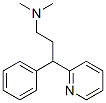Originator
Trimeton Maleate, Schering ,US,1948
Uses
Pheniramine is an antigripal drug. Also, it is derived from 2-Benzylpyridine (B288740), which is a benzylpyridine with antifungal properties. 2-Benzylpyridine is also used as a chromogenic reagent for micro determination of Molybednum.
Definition
ChEBI: N,N-dimethyl-3-phenyl-3-(2-pyridinyl)-1-propanamine is a tertiary amino compound and a member of pyridines.
Manufacturing Process
According to US Patent 2,676,964: to 1.0 mol of potassium amide in 3 liters of liquid ammonia, is added 1.0 mol of 2-benzylpyridine. After 15 minutes, 1.1 mols of β-dimethylaminoethyl chloride are added. The ammonia is allowed to evaporate and the reaction product decomposed with water and ether extracted. The ether layer is dried over sodium sulfate and after evaporation the residue is distilled, giving the 3-phenyl-3-(2-pyridyl)-N,Ndimethylpropylamine, BP 139°-142°C/1-2 mm. The maleate is produced by reaction with maleic acid.
Therapeutic Function
Antihistaminic
Enzyme inhibitor
This antihistamine (FWfree-base = 240.35 g/mol; CAS 86-21-5; insoluble in water; maleate and p-aminosalicylate salts are water-soluble), also known as N,N-dimethyl-g-phenyl-2-pyridinepropanamide, is more frequently abused than other antihistamines relative to its market share. One of the histamine H1 antagonists with little sedative action, pheniramine is often used in treatment of hay fever, rhinitis, allergic dermatoses, and pruritus. Target(s): H1 histamine receptor; and histamine N�methyltransferase, mildly inhibited.
